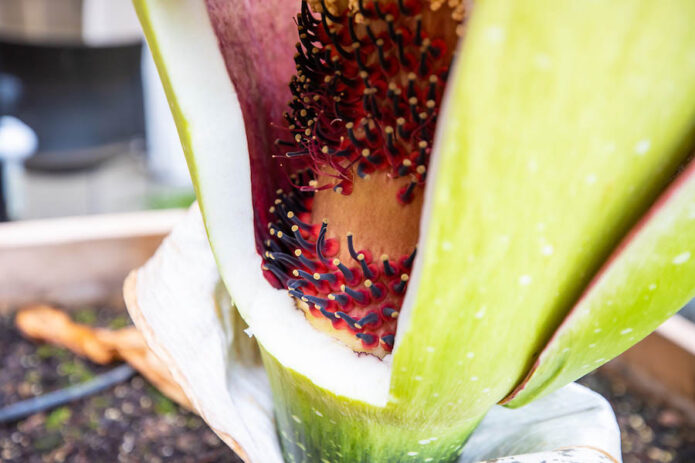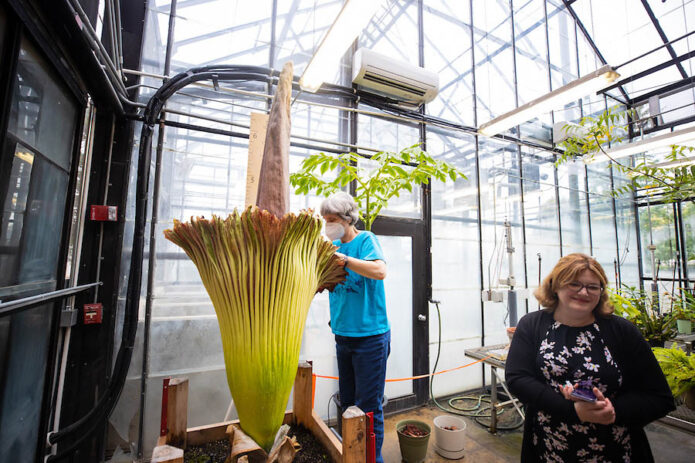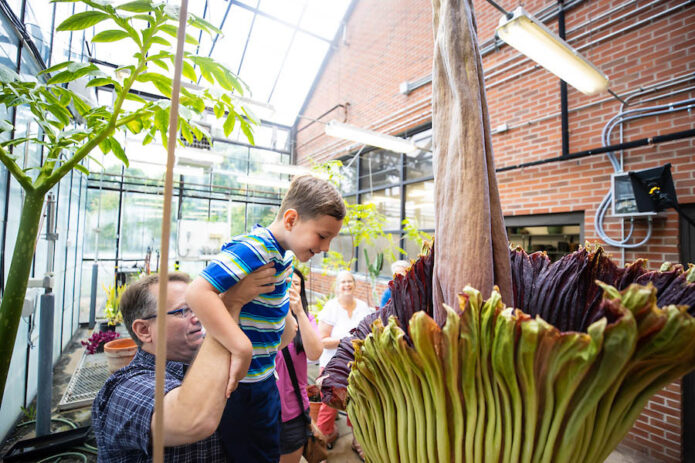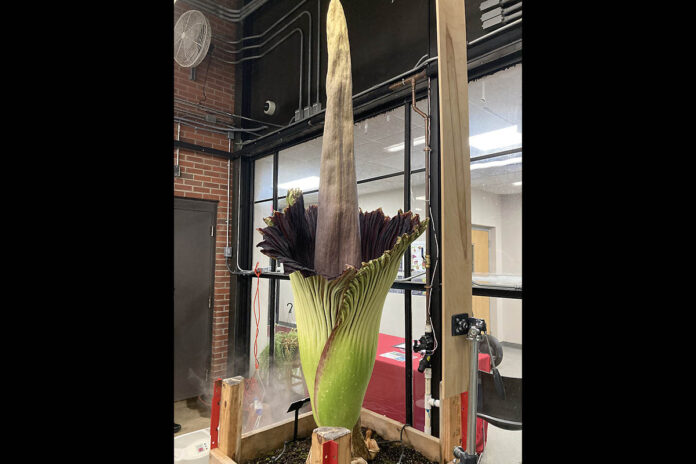 Clarksville, TN – Zeus – one of Austin Peay State University’s two corpse flower plants – delivered quite a show for its first-ever bloom.
Clarksville, TN – Zeus – one of Austin Peay State University’s two corpse flower plants – delivered quite a show for its first-ever bloom.
Thousands of people trekked to the Sundquist Science Complex greenhouse in early June to witness Zeus grow to more than 6 feet tall before unfurling into its burgundy magnificence – while also emitting a rancid stench of cheese, sweat, garlic, decomposing meat, feces, and rotting fish.
Television stations across the state – and the country – picked up the story, and by the second night, the line of people who wanted to smell Zeus snaked through the building. People left with more than 2,500 “I saw Zeus at Austin Peay State University” stickers.
And the livestream via the APSU Department of Biology’s corpse flower plant webpage attracted more than 15,000 views. Combined, people spent about 5,500 hours watching the livestream.

Indeed, Zeus’ bloom captured Clarksville’s attention.
But what’s next for the 10-year-old corpse flower plant – known to scientists as Amorphophallus titanum or titan arum? And what about Zeus’ sibling plant, which won’t earn a nickname until its first flowering?
Zeus might produce fruit – but maybe not

Zeus’ bloom was a rare event. Although corpse flower blooms are becoming more common in cultivation, they’re still extremely rare. As of 2019, only about 500 corpse flower plants lived in university or private collections or botanical gardens.
Even rarer than a bloom, though, is witnessing a corpse flower plant produce fruit. As noted in this 2021 article in The Atlantic, corpse flowers produce recalcitrant seeds that can’t be easily stored because drying and freezing them – the way most seeds are preserved – will kill them. Finding genetically diverse plants that are blooming at relatively the same time is difficult. Still, titan arum flowerings in cultivation are much more common than they were 40 years ago.
“We can get a dozen or more flowerings in a single flowering season, and that’s why we were able to get pollen from a plant that was flowering two to three weeks ago at Dartmouth College to pollinate the (plant) here,” said Jonathan Ertelt, who as Vanderbilt University’s greenhouse manager donated two corpse flower plants to Austin Peay’s Dr. Carol Baskauf in recent years.
On June 10th at about 8:15am, Ertelt brushed the pollen from the Dartmouth plant onto the female flowers inside Zeus’ base. If the female flowers were receptive and if the pollen remained viable after that much time and travel, Zeus might produce fruit that could ripen in early 2023.
A corpse flower plant’s reproductive stage is complex. The plant does not self-pollinate, and the male and female flowers do their jobs at specific times during the bloom. To learn more, read this Chicago Botanic Garden FAQ.
Baskauf also collected Zeus’ pollen and will store it until another institution needs it.
If Zeus produces fruit, the seeds can be planted to grow new corpse flower plants.
In the meantime, Zeus’ flowering structure will continue to wilt as it approaches dormancy.
If all goes well, Zeus will bloom again, probably in 2-3 years.

Zeus needed 10 years to bloom for the first time. Most corpse flower plants need 8-10 years to produce their first bloom. Once a plant blooms, however, the corm – a giant underground tuber – is already big enough to support a much quicker bloom.
Corpse flower plants have odd lifecycles. Here’s the lifecycle, according to the Chicago Botanic Garden’s website. The plants have two main stages – the leaf stage when it grows into a giant leaf with many complex leaflets, and the flower cycle when it blooms and tries to reproduce.
The Leaf Cycle
- In the leaf cycle, the leaf grows rapidly, sometimes reaching a height of 15 feet. Even though the leaf looks like a tree at that height, it’s a single leaf with many leaflets.
- The leaf gathers the sun’s energy for 12-18 months, storing nutrients in the ever-enlarging corm until the above-ground part of the plant (the leaf) finally dies.
- The plant goes dormant for three to six months.
- When the plant emerges from dormancy, it either starts a new leaf cycle – this time with a bigger leaf supporting a bigger corm – or enters the flower cycle. It’s difficult to know which cycle is about to start.
The Flower Cycle
- A plant enters its first flower cycle 7-10 years into the plant’s life and lasts only a day or two (24-36 hours).
- A flowering structure can grow up to 8 feet tall, and it emits that horrible corpse odor when it blooms. A 2010 scientific study found that the corpse flower smells like a combination of cheese, sweat, garlic, decomposing meat, feces and rotting fish. The plant uses the odor to attract pollinators like flies and carrion beetles.
- If the plant blooms and is pollinated (often by hand in a cultivated environment as described above), it will produce fruit for the next nine months or so before re-entering dormancy and restarting the cycle.
- Once a plant blooms, it may bloom again in as little as two or three years.
Meet Zeus’ sibling, now in its leaf cycle

Ertelt gave the first plant to Baskauf – a botany professor in the APSU Department of Biology – in 2018 and the second plant in 2020.
The second plant is Zeus’ “sibling” and is the same age, but because Ertelt grew the plant in a cooler room, it hasn’t grown as fast as Zeus. Still, the second plant could enter its first flower cycle in the next few years.
Once that happens, it will earn a nickname just like Zeus.



